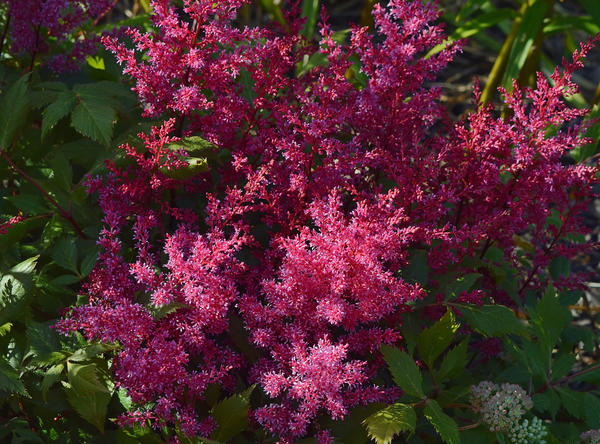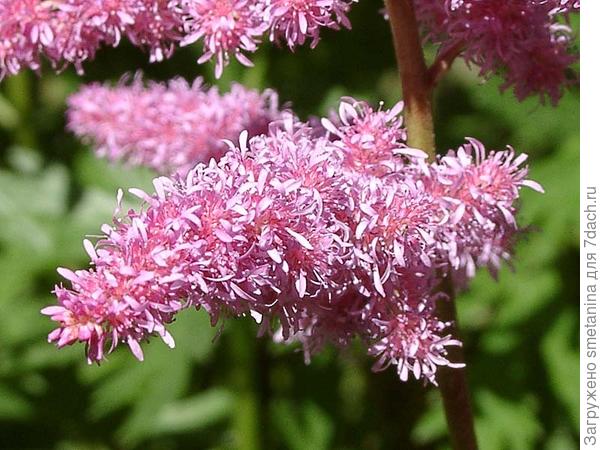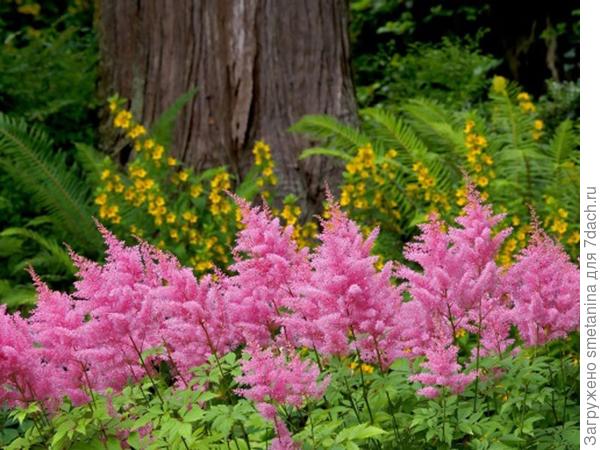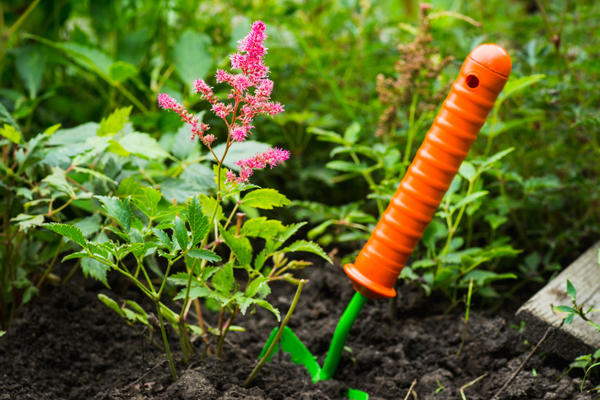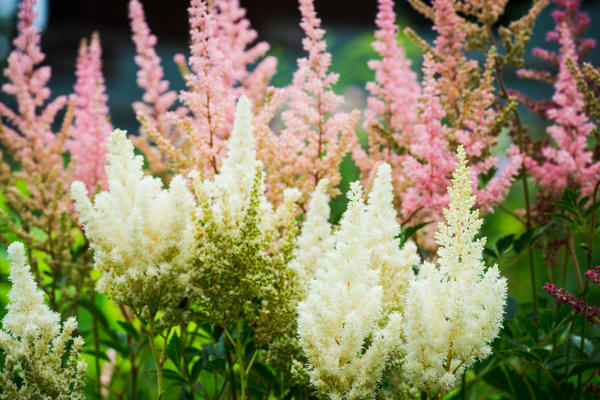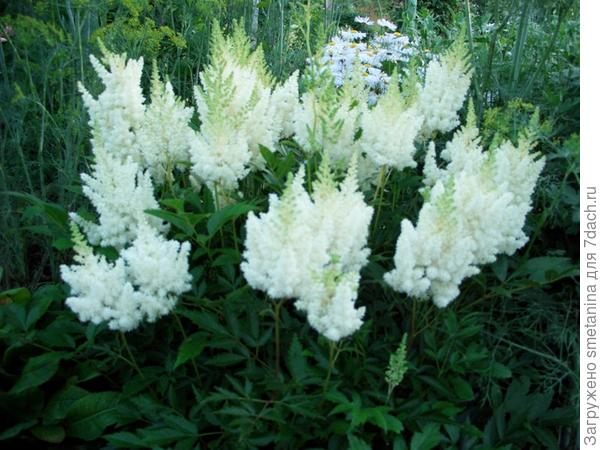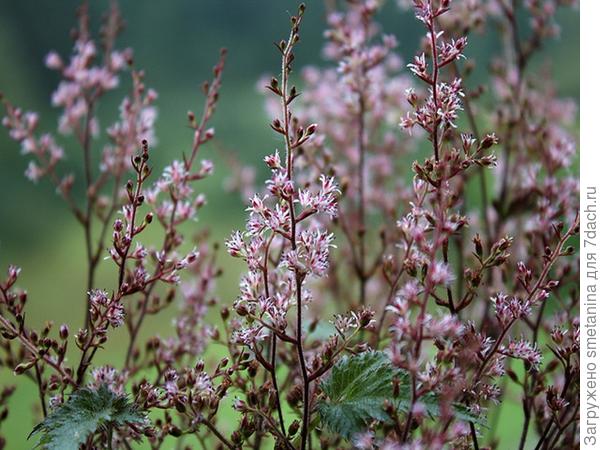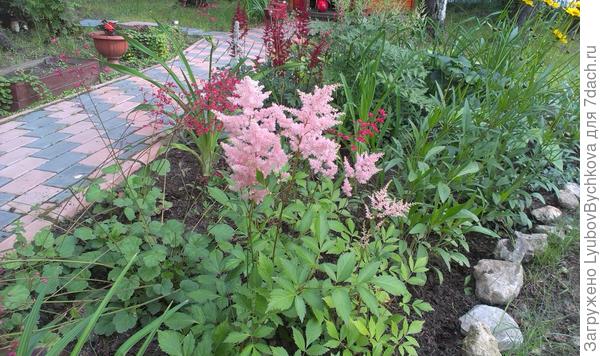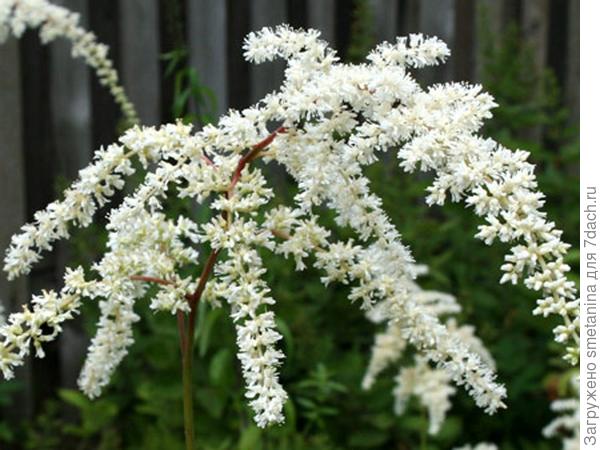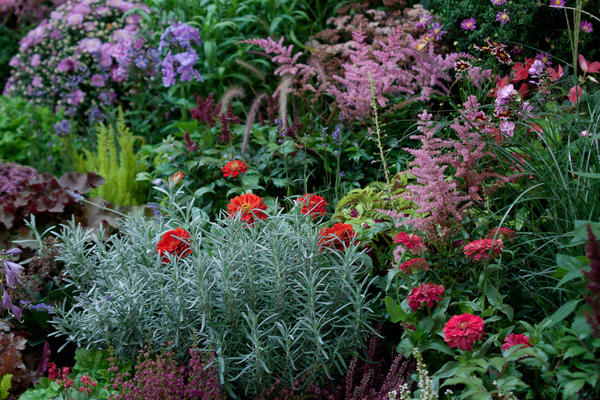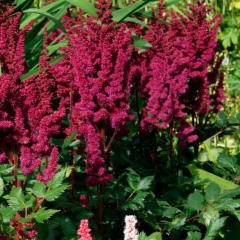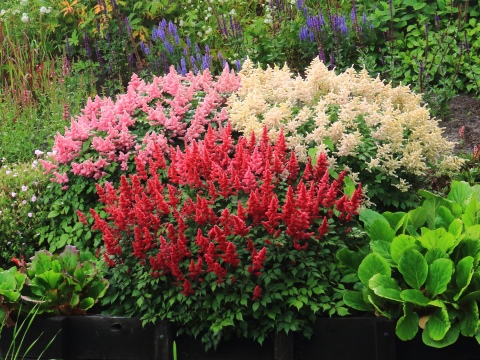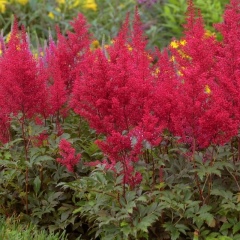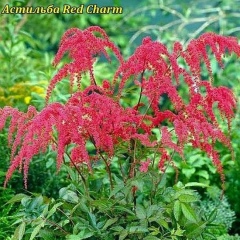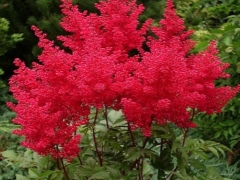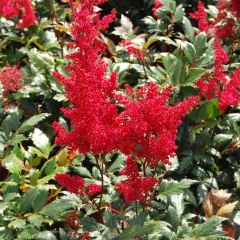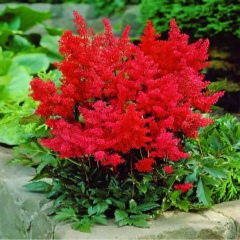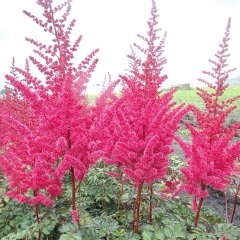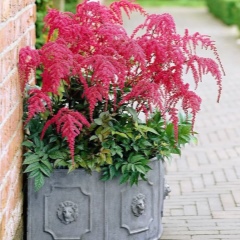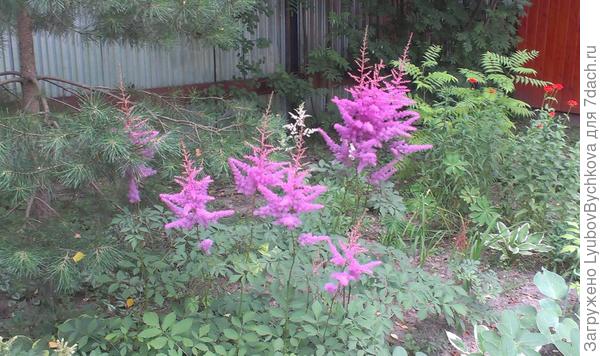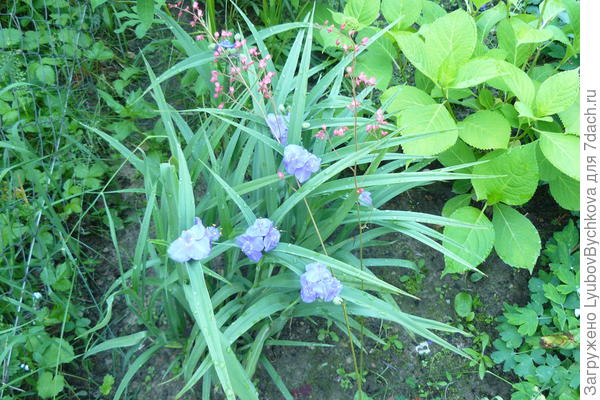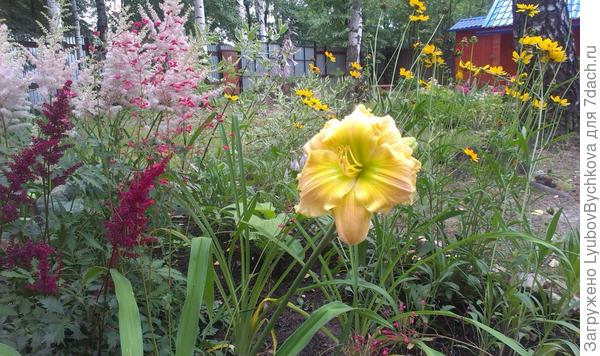Care
Astilbe does not need constant careful care, she is loyal and hardy. Regular watering, combined with proper feeding and loose soil, allows you to grow attractive shrubs with minimal labor.
Watering and spraying
In order to grow lush healthy astilbe varieties Visions in red, it is necessary to monitor the degree of soil moisture at the roots. Drying of the earth and rhizomes should not be allowed, this can lead not only to a deterioration in appearance, but also to the death of the flower. Plants need to be watered often, especially in dry weather, and at low levels of humidity, spray irrigation can be supplemented.
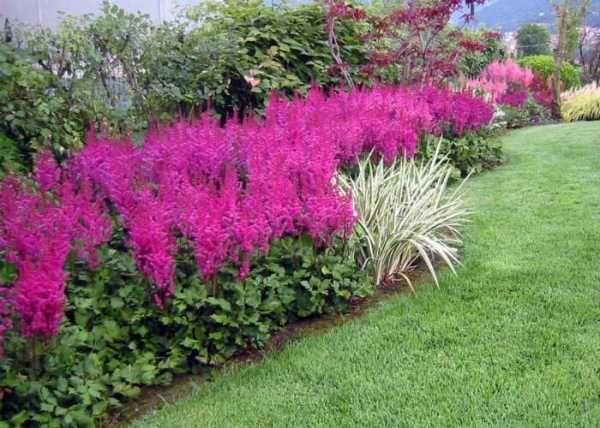
Fertilizing and loosening the soil
The complex of fertilizers for the fruitful growth of astilba depends on the quality of the soil. It is advisable to add compost and peat to dry soil; for wet soil, it is enough universal feeding for flowering plants. When planting bushes, mineral fertilizers and bone meal with humus are added to the soil. After the end of flowering, potassium-phosphorus fertilizers can be added to the soil poor in composition. It is advisable to accompany each watering by loosening the soil so that moisture and oxygen flow to the roots of the plant.
Formation of bushes
To improve the decorative effect of the culture, it is worth completely cutting off dry and damaged shoots. In order to maintain attractiveness, it is also recommended to remove the peduncles at the end of flowering. It is advisable to divide the growing bushes into parts every 4 years in order to relieve the load and return the decorative effect of astilba. The rhizomes must be cut into pieces, keeping at least one replacement bud, and the bushes must be planted in a new place.
Prevention of insects and diseases
Natural pests of astilbe are absent in the middle lane, however, plants can infect nematodes or strawberry worms. The appearance of brown spots, growths on the roots and deformation of leaves can be prevented by using fungicides in time.
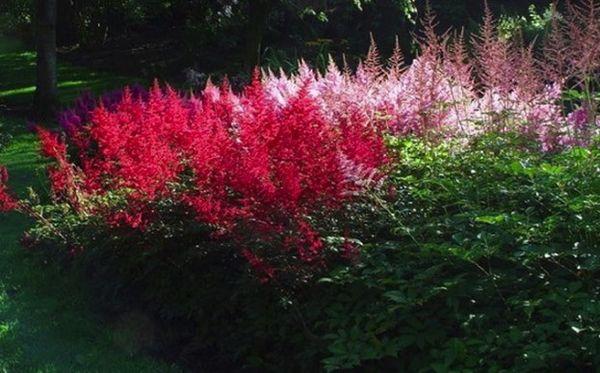
Pennitsa larvae can cause damage to the bushes, which makes the flower wither and lose its green part. To combat the pest, you can use "Karbofos", which is also suitable for prophylaxis.
Astilba can pick up viral or fungal infections from nearby plants. The easiest way to protect the plant is by timely removal of weeds and damaged areas, as well as preventive spraying with Fitoverm, Confidor or analogs.
How to protect a plant from frost
In autumn, after the end of the growing season, the aboveground part of the Vision flowers is completely cut off. In conditions of severe frost or insufficient snow cover, it is recommended to protect the bushes from freezing. Visions in red can be covered with natural or artificial materials.
Landing
The place for your Queen must, of course, choose a royal one - sunny, protected from the north wind, not in a lowland and with fertile soil.
This strawberry grows well on light loam or sandy loam soils. Swampy and heavy soils are not at all suitable for her. The acidity is desirable low, in the range of pH 5.0-6.0.
To determine acidity, you can purchase an electronic device without batteries. It is inexpensive, very simple and easy to use.
It is preferable to plant strawberries after green (spinach, dill, etc.), cereals, crucifers, clover, onions, garlic, carrots and any siderates. Not recommended - after nightshades, cabbage and cucumbers. If nematodes have been detected in the soil, the soil must be completely cured first! To do this, the entire area is densely sown with oats. Nematofagin is used for soil cultivation.
Photo gallery: determination of nematodes in soil
The presence of a nematode can be easily identified by these moves Nematodes make moves in the leaves of a nematode infested land
Best time to plant: July-August. If planted in the fall, then you need to cut off all the resulting peduncles. Can be planted in spring if you are sure there will be no return frosts.
In the fall, strawberries can be planted under shelter.
Strawberries are planted with ready-made seedlings or rosettes from uterine bushes and mustaches. Rosettes should be with two or three leaves and small roots.
Planting is best in cloudy, dry weather.
Before planting, it is necessary to prepare the site: dig up a shovel on a bayonet, removing weed roots and stones, loosen and level. Mark the area in accordance with the number of seedlings and dig the required number of holes. The size of the holes depends on the size of the strawberry root system.
Too large root system needs to be pruned. Dry and unsightly leaves are best removed.
Cut off excess roots and bad leaves before planting.
The queen takes up a lot of space, so the bushes need to be planted according to the scheme: 25–30 cm between bushes and 55–70 cm between rows.
Strawberry planting plan Queen Elizabeth
When planting, mineral (for example, calcium nitrate - 15–20 g per well) or organic (rotted manure) fertilizers must be added to each hole.
Strawberry roots that are too long should be pruned. If you bought strawberries with a lump of earth, then it is better to remove the soil by soaking it in warm water and examine the roots.
It may be that the root system has outgrown the glass, but all the bent roots do not take root. Strawberries will take longer to recover. It is better to do everything right right away, and the plant will take root in a new place faster. As a result, you will immediately get a good harvest.
Remove the strawberries from the glass and examine the roots
Before planting, the roots must be straightened and planted, preventing them from bending upwards. It is very good to use when planting any of their root stimulants (Kornevin, HB-1, Heteroauxin and the like). It is also a good idea to add ExtraFlor white mustard extract. It is bio-protection against nematodes and plant strengthening.
Step-by-step instructions for planting strawberries
- We put a mound at the bottom of the hole. Add fertilizer and water the hole. Next, we put a bush of strawberries, spreading the roots down the hill. We cover the roots with earth. In this case, you need to be careful not to deepen the heart of the bush (otherwise it will rot).
Follow the strawberry heart
- After planting, cover the strawberry plants with covering material (or plastic bottles with slots).
So you can cover the strawberry seedlings and air them through the cork.
- Water when the top layer of the earth dries out. We fertilize before the first harvest with foliar dressing (you can make a solution from ash and spray the strawberries or buy a special fertilizer for this plant).
The best neighbors in a flower arrangement
Peony is undemanding to neighbors, however, it must be borne in mind that the bushes of the culture are large. Therefore, it is necessary to carefully select flowers in a flower bed.

Foliage texture
Peonies will not develop normally next to plants that grow more than the bush itself. Therefore, it is necessary to select crops that have the same leaf texture as peonies, filling the space on the flower garden.
Phlox
Plants can be used with peonies in the composition. They do not have common pests, therefore they do not affect the development of each other. However, it is recommended not to plant at a close distance from each other, leaving room for loosening the soil.
Irises
Unlike peonies, the roots of irises are located in the upper layers of the soil, so these two varieties of crops can be planted on the site. In addition, externally, plants are combined in landscape design.
Sedum
Peony and stonecrop have a similar structure of bush and foliage.Therefore, they can be planted in the same area as the main plants, however, a distance of at least 50 cm must be maintained between the bushes so that the bushes have the necessary space for development.
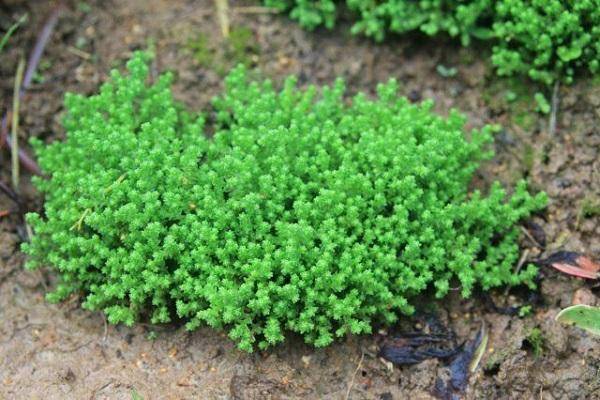
Vertical structure
Peonies can be grown with other tall crop types that exceed shrubs.
Delphinium
The height of the culture is up to 2 meters, it can be grown on the site together with peonies and roses as an additional background for the composition.
Cotton wool
The plant has strong, fleshy stems and can be grown in conjunction with peonies. The height of the bush is on average 150 cm. The culture blooms in the middle of summer. Therefore, it does not affect the development of peonies.
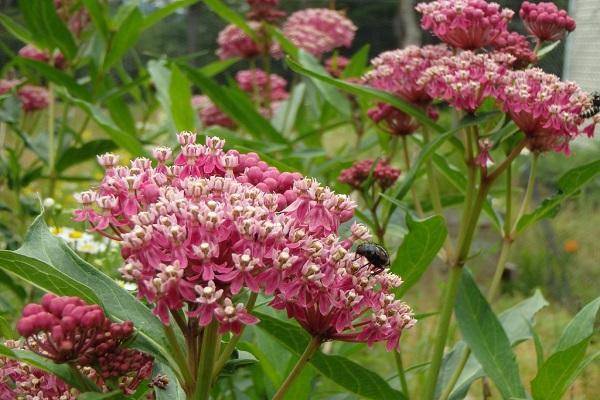
Digitalis
The plant can act as an addition to the appearance of the flower bed, the foxglove blooms at the end of August. Therefore, it does not affect the development of peony buds.
The peony is a decoration of the garden. Peony Red Grace is distinguished not only by its attractive appearance, but also by resistance to diseases. Despite the fact that the plant is odorless, the peony is a popular crop.
How to choose?
The most winter-hardy and frost-resistant varieties are suitable for Russian gardens. For example, large-leaved hydrangea tolerates long winters and late spring quite well, container growing is recommended in very cold regions. So, early blue variety with large purple-blue flowers tolerates planting in a pot.
For the southern regions of Russia, the tree hydrangea, belonging to the light-loving species, is perfect. True, it is still planted in partial shade, but a long daylight hours favorably affect the flowering of the plant. Winter hardiness varieties of tree hydrangea low, it is better to grow them not north of the Chernozem region.
The serrated hydrangea also does not belong to frost-resistant varieties; a warm climate is more suitable for it. It is quite decorative, changing colors depending on the acidity of the soil. The panicle hydrangea is suitable for the climate of the Moscow region or north-west of Russia, it tolerates planting well in swampy areas of the soil. The species is distinguished by beautiful flowering with lush clusters of inflorescences. High frost resistance, among the popular varieties - Grandiflora, which changes color during the season.
For planting in the Far East, Sakhalin, the following species are successfully used: large-leaved, paniculate, tree-like and multi-pubescent hydrangea. This climate is well suited for growing members of the Hydrangea genus, and growers always have a wide variety of varieties to choose from.
For the types and varieties of hydrangea, see the next video.


